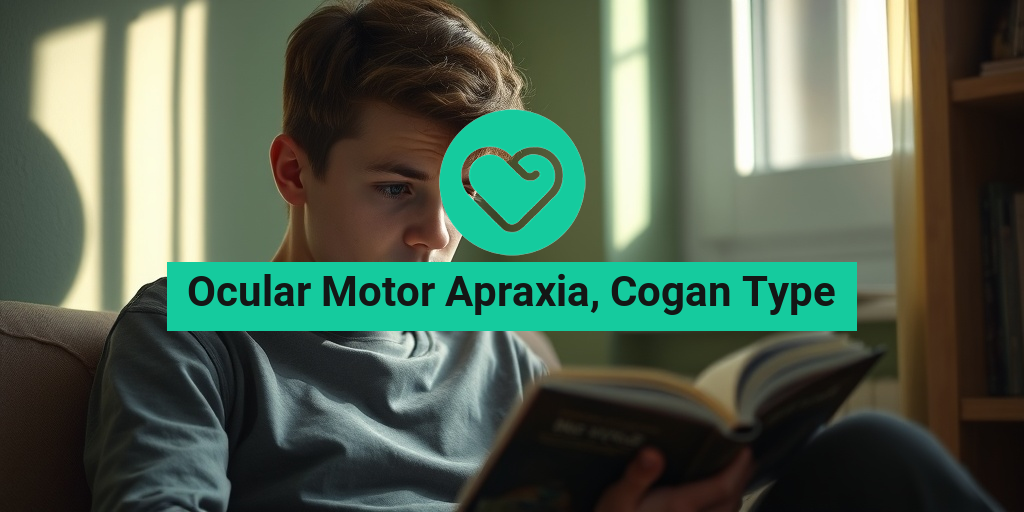What Is Ocular Motor Apraxia?
Ocular Motor Apraxia, Cogan Type is a rare neurological condition that primarily affects the ability to control eye movements. This disorder is characterized by difficulty in initiating voluntary eye movements, which can lead to challenges in tracking objects and maintaining visual attention. Individuals with this condition often find it hard to move their eyes smoothly from one point to another, which can significantly impact their daily activities and overall quality of life.
The term “apraxia” refers to a motor disorder caused by brain damage, where a person has difficulty performing tasks or movements when asked, despite having the desire and physical ability to do so. In the case of ocular motor apraxia, the brain struggles to coordinate the muscles that control eye movement, leading to the characteristic symptoms of the condition.
Understanding Cogan Type
Cogan Type of ocular motor apraxia is named after Dr. David Cogan, who first described the condition. It is often associated with other neurological disorders, such as ataxia and nystagmus, and can occur in both children and adults. The exact cause of Cogan Type ocular motor apraxia is still under investigation, but it is believed to involve dysfunction in specific areas of the brain responsible for eye movement control.
Symptoms of Cogan Type
The symptoms of ocular motor apraxia, Cogan Type, can vary from person to person, but they typically include:
- Difficulty initiating eye movements: Individuals may struggle to start moving their eyes in the desired direction, often appearing as if they are staring or unable to focus.
- Inability to track moving objects: Following a moving object with the eyes can be challenging, leading to frustration and difficulty in activities such as watching television or playing sports.
- Head thrusting: To compensate for their eye movement difficulties, individuals may tilt or thrust their heads in the direction they want to look, which can lead to neck strain over time.
- Visual disturbances: Some may experience double vision or blurred vision due to the inability to coordinate eye movements effectively.
- Difficulty with reading: The challenges in eye movement can make reading a strenuous task, as individuals may find it hard to move their gaze smoothly across lines of text.
Impact on Daily Life
The symptoms of ocular motor apraxia can significantly affect an individual’s daily life. Simple tasks such as driving, reading, or even engaging in conversations can become overwhelming. The frustration of not being able to control eye movements can lead to social withdrawal and emotional distress. Therefore, early diagnosis and intervention are crucial for managing the condition effectively.
Seeking Help
If you or someone you know is experiencing symptoms of ocular motor apraxia, it is essential to consult a healthcare professional. A thorough evaluation by a neurologist or an ophthalmologist can help determine the underlying causes and develop a tailored treatment plan. Resources like Yesil Health AI (yesilhealth.com) can provide valuable, evidence-based health answers to help you understand the condition better and explore potential management strategies.
In conclusion, ocular motor apraxia, Cogan Type, is a complex condition that requires understanding and support. By recognizing the symptoms and seeking appropriate help, individuals can navigate the challenges posed by this disorder and improve their quality of life. Remember, you are not alone in this journey, and there are resources available to assist you! 🌟

Causes of Ocular Motor Apraxia
Ocular Motor Apraxia, Cogan Type is a rare neurological condition that primarily affects the ability to control eye movements. Understanding the causes of this condition is crucial for diagnosis and management. While the exact cause of Cogan Type Ocular Motor Apraxia remains unclear, several factors have been identified that may contribute to its development.
Genetic Factors
One of the primary suspected causes of Cogan Type Ocular Motor Apraxia is genetic predisposition. Research indicates that this condition may be linked to specific genetic mutations. These mutations can affect the brain’s ability to coordinate eye movements, leading to the characteristic symptoms of the disorder. Genetic testing may be recommended for individuals with a family history of similar conditions.
Neurological Conditions
Ocular Motor Apraxia can also be associated with other neurological disorders. Conditions such as cerebellar ataxia or multiple sclerosis may lead to the development of ocular motor apraxia. These disorders can disrupt the pathways in the brain responsible for eye movement control, resulting in difficulties with visual tracking and gaze shifting.
Developmental Factors
In some cases, Cogan Type Ocular Motor Apraxia may arise during early development. Factors such as premature birth or complications during pregnancy can impact brain development, potentially leading to ocular motor issues later in life. Early intervention and therapy can be beneficial in managing symptoms associated with developmental ocular motor apraxia.
Environmental Influences
While less common, certain environmental factors may also play a role in the onset of ocular motor apraxia. Exposure to toxins or infections during critical periods of brain development could potentially disrupt normal neurological function. However, more research is needed to fully understand these environmental influences.
Risk Factors for Cogan Type
Identifying the risk factors associated with Ocular Motor Apraxia, Cogan Type can help in early detection and intervention. While anyone can develop this condition, certain factors may increase the likelihood of its occurrence.
Family History
A significant risk factor for developing Cogan Type Ocular Motor Apraxia is a family history of the condition or related neurological disorders. If a close relative has been diagnosed with ocular motor apraxia or similar conditions, the risk of developing the disorder may be higher.
Age and Gender
Ocular Motor Apraxia can affect individuals of any age, but it is often diagnosed in childhood or early adulthood. Additionally, some studies suggest that males may be more frequently affected than females, although the reasons for this disparity are not yet fully understood.
Coexisting Medical Conditions
Individuals with certain medical conditions, such as autism spectrum disorder or developmental coordination disorder, may be at an increased risk for ocular motor apraxia. These conditions can impact motor skills and coordination, which may overlap with the symptoms of ocular motor apraxia.
Neurological Disorders
As mentioned earlier, the presence of other neurological disorders can heighten the risk of developing Cogan Type Ocular Motor Apraxia. Conditions that affect the brain’s motor control pathways can lead to difficulties in eye movement coordination, making it essential for healthcare providers to consider these factors during diagnosis.
Environmental and Lifestyle Factors
While less understood, certain environmental and lifestyle factors may contribute to the risk of ocular motor apraxia. For instance, exposure to environmental toxins or significant stress during critical developmental periods could potentially influence neurological health. Maintaining a healthy lifestyle and minimizing exposure to harmful substances may help reduce risk.
In summary, understanding the causes and risk factors associated with Ocular Motor Apraxia, Cogan Type is vital for effective management and support. Early diagnosis and intervention can significantly improve the quality of life for those affected by this condition. 🌟

Diagnosis of Ocular Motor Apraxia
Diagnosing Ocular Motor Apraxia, Cogan Type can be a complex process, as it often requires a thorough understanding of the patient’s medical history and a series of specialized tests. This condition primarily affects the ability to move the eyes voluntarily, leading to challenges in tracking objects and maintaining visual focus. Here’s how healthcare professionals typically approach the diagnosis:
Clinical Evaluation
The first step in diagnosing ocular motor apraxia is a comprehensive clinical evaluation. During this assessment, the doctor will:
- Review the patient’s medical history, including any neurological conditions or symptoms.
- Conduct a physical examination, focusing on eye movements and coordination.
- Ask about any difficulties with vision, such as trouble following moving objects or maintaining eye contact.
Neurological Examination
A detailed neurological examination is crucial for identifying any underlying issues that may contribute to ocular motor apraxia. This may include:
- Assessing reflexes and muscle strength.
- Evaluating coordination and balance.
- Testing cognitive functions to rule out other neurological disorders.
Specialized Eye Tests
To confirm a diagnosis of ocular motor apraxia, healthcare providers may utilize specialized eye tests, such as:
- Eye Movement Recording: This test tracks eye movements to assess how well the eyes can follow a target.
- Visual Field Testing: This evaluates the full range of vision and helps identify any blind spots.
- Electroretinography: This test measures the electrical responses of the retina to light, helping to rule out retinal diseases.
In some cases, imaging studies like MRI or CT scans may be recommended to visualize the brain and rule out structural abnormalities that could affect eye movement.
Treatment Options Available
While there is currently no cure for Ocular Motor Apraxia, Cogan Type, various treatment options can help manage symptoms and improve quality of life. The treatment plan is often tailored to the individual, depending on the severity of the condition and associated symptoms. Here are some common approaches:
Vision Therapy
Vision therapy is a non-surgical treatment option that focuses on improving eye coordination and movement. This therapy may include:
- Eye exercises: These exercises help strengthen the eye muscles and improve control over eye movements.
- Visual tracking activities: Engaging in activities that require following moving objects can enhance tracking skills.
- Computer-based programs: Some programs are designed to improve visual processing and eye-hand coordination.
Occupational Therapy
Occupational therapy can be beneficial for individuals with ocular motor apraxia, as it helps them adapt to daily activities. Therapists may work on:
- Strategies for improving reading skills, such as using larger print or audio books.
- Techniques for enhancing hand-eye coordination in tasks like writing or using a computer.
- Adaptive tools and technologies that can assist with daily living activities.
Medications
In some cases, medications may be prescribed to manage associated symptoms, such as anxiety or attention difficulties. These medications can help improve overall functioning and quality of life.
Supportive Therapies
Supportive therapies, including counseling and support groups, can also play a vital role in managing ocular motor apraxia. Connecting with others who understand the challenges can provide emotional support and practical advice. Additionally, family education is essential to help loved ones understand the condition and how to assist effectively.
In conclusion, while the diagnosis and treatment of Ocular Motor Apraxia, Cogan Type can be challenging, a comprehensive approach involving various therapies and support systems can significantly improve the quality of life for those affected. 🌟

Living with Ocular Motor Apraxia
Ocular Motor Apraxia, Cogan Type, is a rare neurological condition that affects the ability to control eye movements. For those diagnosed with this condition, daily life can present unique challenges. Understanding these challenges and finding effective coping strategies is essential for improving quality of life.
Understanding the Condition
Ocular Motor Apraxia is characterized by difficulty in initiating voluntary eye movements. Individuals may struggle to look in different directions or follow moving objects with their eyes. This can lead to frustration and impact various aspects of life, including reading, driving, and social interactions.
Common Symptoms
People living with Ocular Motor Apraxia may experience a range of symptoms, including:
- Difficulty with Eye Movements: Inability to move the eyes smoothly or quickly.
- Head Movements: Compensatory head movements to assist with vision.
- Visual Discomfort: Strain or discomfort when trying to focus on objects.
- Difficulty Reading: Challenges in tracking lines of text.
Coping Strategies
Living with Ocular Motor Apraxia can be daunting, but there are several strategies that can help individuals manage their symptoms:
- Occupational Therapy: Working with an occupational therapist can provide tailored exercises to improve eye movement control.
- Assistive Devices: Tools like magnifiers or specialized glasses can enhance visual clarity and ease reading.
- Environmental Modifications: Adjusting lighting and reducing clutter can help minimize distractions and improve focus.
- Support Groups: Connecting with others who have similar experiences can provide emotional support and practical advice.
Emotional and Psychological Impact
The challenges of Ocular Motor Apraxia can also take a toll on mental health. Feelings of frustration, anxiety, or isolation are common. It’s important for individuals to seek support from mental health professionals when needed. Engaging in mindfulness practices, such as meditation or yoga, can also help manage stress and improve overall well-being. 🧘♂️
Future Research Directions
As awareness of Ocular Motor Apraxia, Cogan Type, grows, so does the need for further research. Understanding the underlying mechanisms of this condition is crucial for developing effective treatments and interventions.
Genetic Studies
Research into the genetic factors contributing to Ocular Motor Apraxia is a promising area. Identifying specific genes associated with the condition could lead to better diagnostic tools and targeted therapies. Genetic studies may also help in understanding the hereditary patterns of the disorder, providing valuable information for families affected by it.
Neuroimaging Techniques
Advancements in neuroimaging technologies, such as functional MRI and PET scans, can offer insights into the brain regions involved in eye movement control. By studying the brain activity of individuals with Ocular Motor Apraxia, researchers can identify potential abnormalities and develop targeted rehabilitation strategies.
Clinical Trials
As with many rare conditions, clinical trials play a vital role in advancing treatment options. Ongoing studies are exploring various therapeutic approaches, including:
- Pharmacological Interventions: Investigating medications that may enhance eye movement control.
- Behavioral Therapies: Evaluating the effectiveness of different therapeutic techniques in improving daily functioning.
- Assistive Technology: Developing new devices that can aid individuals in managing their symptoms more effectively.
Community Engagement and Awareness
Increasing awareness about Ocular Motor Apraxia is essential for fostering research and support. Community engagement initiatives, such as awareness campaigns and educational programs, can help inform the public and healthcare professionals about the condition. This, in turn, can lead to earlier diagnosis and better access to resources for those affected. 🌍
In conclusion, while living with Ocular Motor Apraxia presents challenges, understanding the condition and exploring future research directions can pave the way for improved management and support. The journey may be difficult, but with the right resources and community support, individuals can lead fulfilling lives. 💪

Frequently Asked Questions about Ocular Motor Apraxia, Cogan Type
What is Ocular Motor Apraxia, Cogan Type?
Ocular Motor Apraxia, Cogan Type is a neurological condition characterized by difficulty in initiating voluntary eye movements. Individuals with this condition may struggle to move their eyes in the desired direction, which can affect their ability to track moving objects or shift their gaze effectively.
What are the symptoms of Ocular Motor Apraxia?
- Difficulty with eye movements: Individuals may find it challenging to look up, down, or side to side.
- Delayed eye movement: There may be a noticeable delay before the eyes move in response to visual stimuli.
- Head movements: Some individuals may compensate for their eye movement difficulties by moving their heads to see.
- Visual tracking issues: Problems with following moving objects smoothly can occur.
How is Ocular Motor Apraxia diagnosed?
Diagnosis of Ocular Motor Apraxia, Cogan Type typically involves a comprehensive neurological examination, including assessments of eye movement and visual tracking. Healthcare professionals may also use imaging studies to rule out other conditions.
What causes Ocular Motor Apraxia, Cogan Type?
The exact cause of Ocular Motor Apraxia, Cogan Type is not fully understood. However, it is believed to be related to neurological dysfunction affecting the areas of the brain responsible for eye movement control.
Can Ocular Motor Apraxia be treated?
While there is no cure for Ocular Motor Apraxia, Cogan Type, various therapies can help manage symptoms. Occupational therapy and vision therapy may assist individuals in developing strategies to cope with their eye movement difficulties.
Is Ocular Motor Apraxia hereditary?
There is some evidence to suggest that Ocular Motor Apraxia, Cogan Type may have a genetic component, but more research is needed to understand the hereditary aspects fully. If there is a family history of similar conditions, it may be beneficial to consult a healthcare professional.
What should I do if I suspect I have Ocular Motor Apraxia?
If you believe you may have Ocular Motor Apraxia, Cogan Type, it is essential to seek advice from a healthcare provider. They can conduct the necessary evaluations and guide you on the best course of action.




